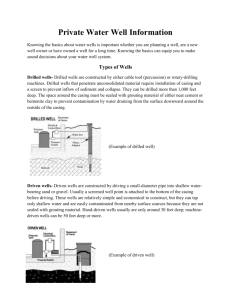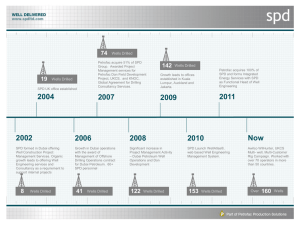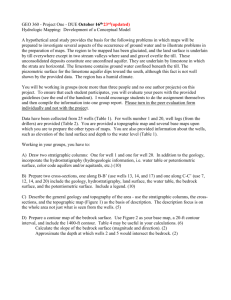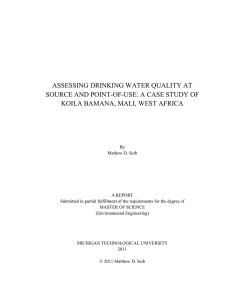Sources of Drinking Water - Government of Nova Scotia
advertisement
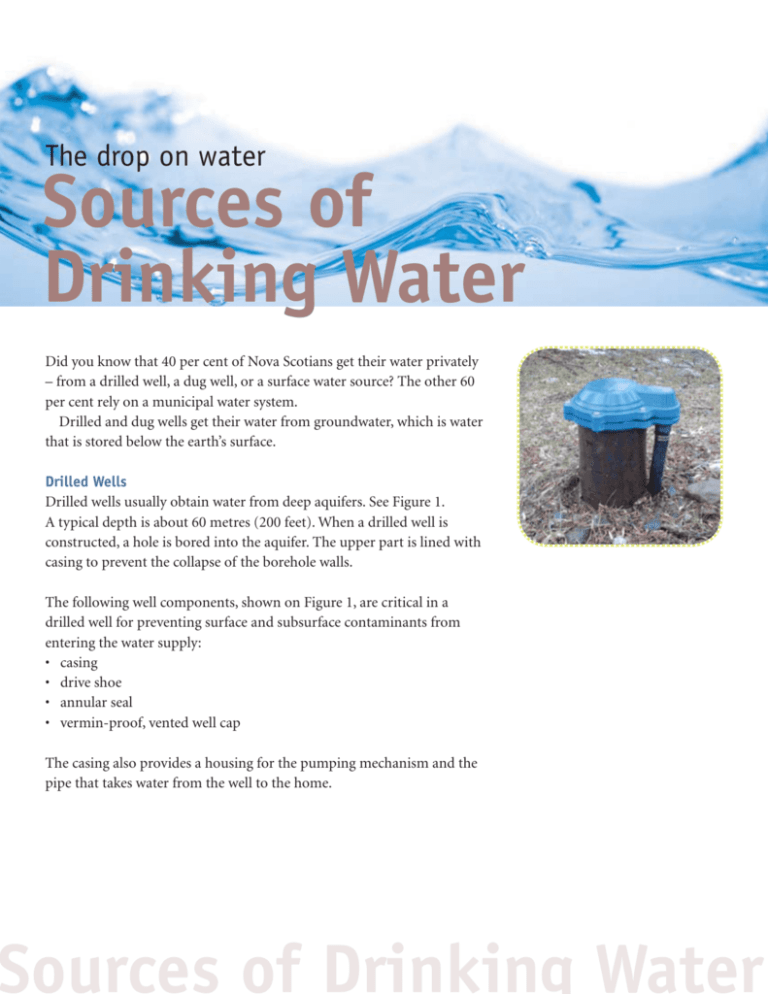
The drop on water Sources of Drinking Water Did you know that 40 per cent of Nova Scotians get their water privately – from a drilled well, a dug well, or a surface water source? The other 60 per cent rely on a municipal water system. Drilled and dug wells get their water from groundwater, which is water that is stored below the earth’s surface. Drilled Wells Drilled wells usually obtain water from deep aquifers. See Figure 1. A typical depth is about 60 metres (200 feet). When a drilled well is constructed, a hole is bored into the aquifer. The upper part is lined with casing to prevent the collapse of the borehole walls. The following well components, shown on Figure 1, are critical in a drilled well for preventing surface and subsurface contaminants from entering the water supply: • casing • drive shoe • annular seal • vermin-proof, vented well cap The casing also provides a housing for the pumping mechanism and the pipe that takes water from the well to the home. Sources of Drinking Water Sources of Drinking W Dug Wells A dug well consists of an excavation into a shallow aquifer. See Figure 2. The typical depth of a dug well is 4.5 to 8 metres (15 to 25 feet). The excavation is lined with concrete crocks, which prevent the collapse of the excavated walls. The following well components, shown on Figure 2, are critical in a dug well for preventing surface and subsurface contaminants from entering the water supply: • crocks • non-toxic seals • apron • casing cap For more information on drilled or dug wells, see our publication Before You Construct a Water Well at www.gov.ns.ca/enla/water/docs/ ConstructWell.pdf. S Water Surface Water Surface water is water found in lakes, streams, and rivers. It is not recommended as a private drinking water source unless properly filtered, disinfected, and monitored for water quality. For more information on surface water as a private drinking water source, see our surface water fact sheet at www.gov.ns.ca/enla/water/ surfacewater/docs/SurfaceWaterQA.pdf. Advantages and Disadvantages of Each Water Source The following table outlines the advantages and disadvantages of each water source. Whether your source of drinking water is a drilled well, a dug well, or a surface source of water, ensure that • Your water is of good quality, free from organisms that may cause disease and from chemical substances that may pose a health risk. • Your water is aesthetically appealing, which means that it is free from objectionable taste, smell, and colour. • You have sufficient water to meet household needs. Considerations To determine the best source of water for your home, consult a qualified well contractor or water professional. Qualified persons installing, maintaining or repairing a well should be familiar with the Nova Scotia Well Construction Regulations at www.gov.ns.ca/just/regulations/regs/envwellc.htm. REGULAR TESTING Homeowners are responsible for monitoring the quality of their well water: • Test for bacterial quality every 6 months. • Test for chemical quality every 2 years. • Test more often if you notice changes in physical qualities – taste, smell, or colour. Regular testing alerts you to problems with your drinking water. Sources of Drinking Water Sources of Drinking W Drilled Well Advantages Disadvantages • can access deeper, confined aquifers • increased protection from surface sources of contaminants and bacteria • reduced vulnerability to drought conditions (but not eliminated) • can often find water bearing fractures with depth, regardless of location • can increase depth of well to increase water column and/or available storage • higher maximum yields (for public or industrial supplies) • cost of installation is usually higher than for dug wells • can penetrate formations that yield water of undesirable quality • health related contaminants, such as arsenic or uranium, that are more common in bedrock formations can be present, requiring treatment • maximum yields are sometimes low even at depth, depending on geologic conditions • drawdown can be large causing adjacent wells to interfere with each other, mainly in aquifers with low permeability • higher electricity cost of pumping deep water Water Dug Well Surface Water Advantages Disadvantages • usually less expensive than drilled wells • draw water from sand and gravel deposits that are less likely to contain contaminants associated with bedrock aquifers • it may be easier to find a well digger than a well driller, since there are usually more well diggers within a community • large storage volume in crocks and gravel reservoir (which helps off-set the limited water column) • usually installed in unconfined aquifers, which may be more susceptible to contamination from surface and nearsurface sources, such as from septic systems (especially bacteria) • affected by seasonal water table fluctuations • possible only if the water table is relatively high on the property to be serviced • well can run dry with high water use • maximum depth limited by method of installation • water seeps in only through base and joints of well • maximum yields are often low in Nova Scotia due to the prevalence of clayey glacial till • well construction often not sufficient to prevent vermin from entering well, which may lead to bacterial contamination • ultraviolet light water disinfection is often recommended due to the higher potential for bacterial contamination Advantages Disadvantages • may not have a restricted capacity • Surface water sources contain microorganisms, such as bacteria, viruses, and parasites, that can cause cramps, nausea, vomiting, and diarrhea, and in some cases more serious, or even fatal, illnesses • requires filtration and disinfection to be properly treated for domestic use • greater system maintenance required • high operational cost Sources of Drinking W Figure 1 Cross-section of a typical drilled well Vermin-proof, vented well cap Mounded earth Ground surface Surficial material Electrical line to pump Pitless adaptor Water line to house Bedrock Well casing Grout or bentonite (annular) seal Drive shoe Open hole or screen Submersible pump Diagram not to scale. Water Figure 2 Cross-section of a typical dug well Vent (optional) Casing cap Mounded earth Clean, clayey backfill material Concrete or bentonite apron Diagram not to scale. Non-toxic sealing material Crocks with non-toxic sealing material in joints Water line to house Clean, coarse sand or gravel reservoir Foot valve FOR MORE INFORMATION Contact Nova Scotia Environment and Labour at 1-877-9ENVIRO or 1-877-936-8476 www.gov.ns.ca/enla/water/ Washed granite or quartzite crushed stone Environment and Labour 03.2008


